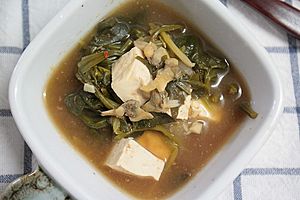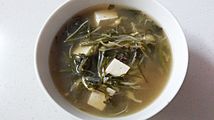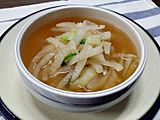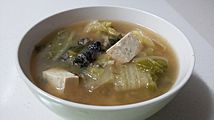Doenjang-guk facts for kids

Sigeumchi-doenjang-guk
(soybean paste soup with spinach) |
|
| Alternative names | Soybean paste soup |
|---|---|
| Type | Guk |
| Place of origin | Korea |
| Associated national cuisine | Korean cuisine |
| Main ingredients | Doenjang |
| Similar dishes | Miso soup |
| Korean name | |
| Hangul |
된장국
|
|---|---|
| Hanja |
-醬-
|
| Revised Romanization | doenjang-guk |
| McCune–Reischauer | toenjang-kuk |
| IPA | [twen.dʑaŋ.k͈uk̚] |
Doenjang-guk (된장국), also known as soybean paste soup, is a popular and comforting soup from Korea. It's made with doenjang, which is a special fermented soybean paste. This soup also includes other yummy ingredients like fresh vegetables, sometimes meat, or even seafood.
Doenjang-guk is usually thinner and lighter than doenjang-jjigae, which is a thicker stew. It's a bit like the Japanese miso soup. Many people in Korea feel that Doenjang-guk represents the heart of their country's food. It can be mild or strong in flavor. Most of the time, it's eaten with rice.
Doenjang-guk is a type of banchan. Banchan are small side dishes served with meals in Korea. Other banchan include kimchi and marinated vegetables. This soup is often one of the most affordable meals you can find in Korea.
Contents
History of Doenjang-guk
During the Joseon period in Korea, the royal family ate five meals a day. These meals were called sura. Doenjang-guk was a common side dish for three of these meals. It was served on a small table next to the main one. This soup was enjoyed with other traditional Korean foods. These included vegetables (chaeso), meat dishes (kogi), eggs, and sesame-seed oil (chamgireum).
What Goes Into Doenjang-guk?
The simplest version of this soup is called Malgeun-doenjangguk. This means "clear soybean paste soup." It's mostly made with well-fermented soybean paste and a flavorful broth. This light soup often goes well with more complex rice dishes. For example, it's great with bibimbap that has lots of ingredients. The ingredients for this simple soup are usually anchovy-kelp broth, vegetable broth, or unsalted chicken broth. Of course, it always has Korean fermented soybean paste. Sometimes, a bit of scallion is added.
The most common type of this dish is Baechu-doenjangguk, which is soybean paste soup with cabbage. People eat it at any time of day. The broth has a deep, comforting taste. The cabbage adds a nice texture and a bit of sweetness. It's a light soup because it doesn't have much grease. The ingredients for this popular soup include dried anchovies for the broth. It also has napa cabbage leaves, white-stemmed chard, or bok choy. Other key ingredients are Korean fermented soybean paste (doenjang), garlic, and chili peppers. Sometimes, a little all-purpose flour or rice water and fish sauce are used.
To make the broth for a doenjang soup or stew, people often use the water from washing rice. This water is called ssalddeumul (쌀뜨물). This rice water adds a bit of starch to the soup. It helps the soybean paste mix well with the broth. It also makes the doenjang taste even better. If you don't have rice water, you can mix in a teaspoon of flour or rice flour instead.
Different Kinds of Doenjang-guk
There are many delicious types of Doenjang-guk, each with its own special ingredients:
- Mu-doenjang-guk (무된장국) is light but full of flavor. It's made with korean radish (mu). It also includes basic vegetables like onion, garlic, scallion, and chili peppers. Dried kelp (dashima) and dried shiitake mushrooms are often used to make the broth.
- Paraetguk / parae-doenjangguk (파랫국 / 파래된장국) is a grassy seaweed soup. It uses seaweed in a broth made from dried anchovies and soybean paste. This is a special dish from Jeju-do, an island in Korea.
- Cheonggyeongchae dubu-doenjangguk (청경채 두부된장국) is made with tofu and bok choy. It also includes gochujang (Korean hot pepper paste) along with the usual broth ingredients.
- Naeng-i Guk (냉이국), or Shepherd's Purse Soup, is similar to mugwort soup (ssuk-guk). It's made with Nangyi (냉이) and gukkanjang. Wild sesame powder is also added. Many other vegetables can be put into this soup.
Gallery
-
Dallae-doenjang-guk (soybean paste soup with Korean wild chives)
-
Dongchimi-doenjang-guk (soybean paste soup with dongchimi)
-
Naengi-doenjang-guk (soybean paste soup with shepherd's purse)
-
Ugeoji-ureong-doenjang-guk (soybean paste soup with ugeoji and river snails)





